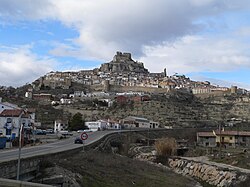Morella, Ports
| Morella | ||
|---|---|---|

Panoramic view of Morella, Ports
|
||
|
||
 Morella in Els Ports |
||
| Country | Spain | |
| Autonomous community | Comunitat Valenciana | |
| Province | Castellón | |
| Comarca | Els Ports | |
| Government | ||
| • Alcalde | Rhamsés Ripollés (PSPV-PSOE) | |
| Area | ||
| • Total | 413.5 km2 (159.7 sq mi) | |
| Elevation | 984 m (3,228 ft) | |
| Population (2016) | ||
| • Total | 2,504 | |
| • Density | 6.1/km2 (16/sq mi) | |
| Time zone | CET (UTC+1) | |
| • Summer (DST) | CEST (UTC+2) | |
| Website | www.morella.net/ | |
| Morella is in the heart of the historic region of Meastrazgo | ||
Morella is an ancient walled city located on a hill-top in the province of Castellón, Valencian Community, Spain. The town is the capital and administrative centre of the comarca of Els Ports, in the historic Maestrat (Maestrazgo) region.
There are traces of settlement by the Iberians, succeeded by the Greeks and Romans, Visigoths and the Moors. From the early 17th century to the Spanish Civil War, the town was often fought over, due to its strategic situation between the Ebro and the coastal plain of Valencia. Morella is part of the Taula del Sénia free association of municipalities.
Every six years the citizens celebrate the Sexenni, a commemoration of the town's recovery from the plague in the seventeenth century. Tourism now plays an important part in the local economy, along with agriculture. In the 20th century the town and surrounding area became depopulated, a trend that has only been reversed in the early 21st century. The population of Morella in 2008 was 2,854, having declined from a figure of 7,335 in 1900 (INE).
One of the typical gastronomic products of Morella is sweets known as flaons. Local bakeries are also renowned for a number of other traditional pastries and sweets, like mantecadas, prepared in the ancient way.
Prehistoric remains in the area include cave paintings in Morella la Vella and Bronze Age graves at Hostal Nou. The Greeks established a treasury at Morella, but then the area became the scene of conflict between the Carthaginians and the Roman Empire during the Punic Wars. Eventually the town was Romanized and became part of the province of Tarragona. The Moors took the town in 714, naming it Maurela.
...
Wikipedia

